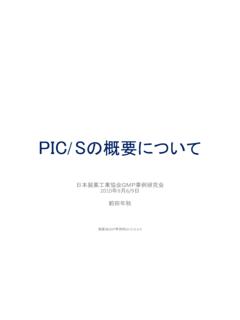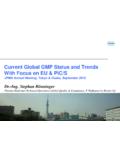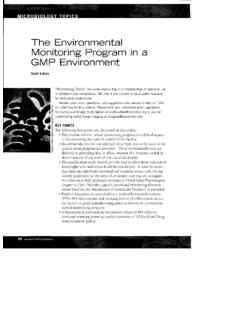Transcription of Examples of critical and major observations from …
1 Examples of critical and major observations from GMP inspections of Manufacturing, QC and Contract Research Organisations Prequalification Programme: Priority Essential Medicines Essential Medicines Policies, WHO, Geneva. Presented by Ian Thrussell Head of Inspections Session Outline This presentation provides a summary of those areas of FPP and API manufacture and their control where deficiencies versus GMP are most commonly found Questions In 2012 Poor quality continues to impact on the patient LAHORE: Isotab contaminated isosorbide tablets supplied by a major cardiac care clinic Mystery behind the factors which have caused THE DEATH OF OVER 100 PATIENTS. Several thousand patients hospitalized Each of them had consumed a chronic overdose of Pyrimethamine every day, which caused immediate bone marrow suppression and a terrible drop in platelet and white blood cell counts, ultimately leading to their deaths. Root cause a simple mix up of an excipient and an API during manufacture THE PRODUCT COMPLIED WITH ITS SPECIFICATION!
2 !!!!!!! BUT WAS LETHAL! Quality GMP: assuring the consistency of quality Since the establishment of GMP the prime objectives set out in law and guidance has been to: Ensure that products are manufactured batch upon batch, year upon year, to the appropriate and consistent quality standards and in accordance with regulatory requirements by requiring that there be a pharmaceutical quality system. HAVING A QMS IS NOT NEW! Require Marketing Authorisation holders to regularly review their products and their manufacturing processes to ensure that they keep up to date with scientific and technological progress CONTINUAL IMPROVEMENT HAS ALWAYS BEEN A REQUIREMENT of most GMPs! 5 Prequalification: Inspection Processes By a team of qualified and experienced inspectors WHO representative (qualified inspector) Inspector from well-established inspectorate (Pharmaceutical Inspection Cooperation Scheme countries PIC/S) National inspector/s invited to be part and observe the inspection Observer from recipient/developing countries (nominated by DRA of the country) Scope: Compliance with specific GXP guidelines: GMP for API and FPP sites, GCP for CROs, GLP for FPP/API factory QCL, CRO-BAL, NQCL, IQCL Data verification data manipulation, falsification, (validation, stability, clinical, bioanalytical) 6 Risk-based approach in: definition and classification of deficiencies Deficiencies are descriptions of non-compliance with GMP requirements.
3 A distinction is made between deficiencies as a result of: - a defective system or, failure to comply with the system. Deficiencies may be classified as: critical observation potential risk harm to the user major observation major deviation from GMP/GCP Minor or Other observation departure from good practice Classification of observations critical observation An observation that has produced, or may result in a significant risk of producing, an API that, when used in a finished product, is harmful to the user. major observation A non- critical observation that: has produced or may produce a product which does not comply with its prequalification application (including variations); and/or indicates a major deviation from the GMP guide; and/or indicates a failure to carry out satisfactory procedures for release of batches; and/or indicates a failure of the person responsible for QA/QC to fulfill his/her duties; and/or consists of several other deficiencies, none of which on its own may be major , but which may together represent a major deficiency and should be explained and reported as such.
4 Other observation An observation that cannot be classified as either critical or major , but indicates a departure from good manufacturing practice. A deficiency may be other either because it is judged as minor, or because there is insufficient information to classify it as major or critical . 7 8 WHO-PQ offers new avenues for collaboration in inspection WHO-PQ Collaborative Procedure in Inspections nominated inspectors from NMRAs of selected member states are invited to participate in WHO-PQ organized inspections and in turn, the NMRAs is given appropriate access to outcomes of these inspections. Capacity building of NMRAs inspectors. Facilitating use of WHO-PQ inspection results in national regulatory environment for information and decision making. Facilitation of harmonization through joint inspections and sharing of outcomes. Share the workload and promote avoiding duplicative inspections. 9 USP BP Ph. Eur. Ph.
5 Int. Prequalification Programme: International norms, standards and guidelines used in inspection activities to ensure wide applicability Other guidelines ICH, ISO #2 Raw Materials Personnel Procedures Validated processes Equipment Premises Environment Packing Materials Quality Assurance and Quality Management Investigations Deviations Out of specification and out of trend results Root cause analysis Change Management Continual Improvement Quality Risk Management Quality Review - APRs Pharmaceutical Development Technology Transfer Manufacturing Discontinuation GMP Management Responsibilities Process Performance & Product Quality monitoring CAPA Change Management Management review PQS elements Quality risk Management Knowledge Management Enablers ICH Q10 Management commitment( ) Senior management has the ultimate responsibility to ensure an effective pharmaceutical quality system is in place to achieve the quality objectives and that the roles, responsibilities, and authorities are defined, communicated and implemented throughout the company.
6 The concept of corporate governance 12 Why do inspectors already look at an organisation s QMS and QRM programmes during inspections? Looking at how companies react when things go wrong or are changing and are under pressure is a major diagnostic indicator of the robustness of the scientific and organisational integrity of a company s operations Do they investigate to improve knowledge or simply build arguments for release of product Quality of investigations- appropriateness of depth of investigation Reactive rather than proactive usage of knowledge Quality is everyone s responsibility Is this true when things go wrong? Is the company a learning organisation? And where is it on the learning curve? Managing Knowledge: Out of Specification, deviations and process failures OOS results may indicate a flaw in product or process design Lack of robustness in product formulation Inadequate raw material characterization or control Substantial variation introduced by one or more unit operations of the manufacturing process Combination of these factors In such cases, it is essential that redesign of the product or process be undertaken to ensure reproducible product quality ) Importance of root cause investigations and risk management Have we identified and do we understand factors that impact product quality?
7 Information is not knowledge. Let s not confuse the two. - W. Edwards Deming We are drowning in information but starved for knowledge. - John Naisbitt Quality philosophy After W Edwards Deming Learning is not compulsory! Adaptation and improvement is not compulsory SURVIVAL IS NOT COMPULSORY ICH Q10 ( Management responsibility) .. : Leadership is essential to establish and maintain a companywide commitment to quality and for the performance of the pharmaceutical quality system 18 19 Inspection of FPP manufacturers Raw Materials Personnel Procedures Validated processes Equipment Premises Environment Packing Materials Poorly understood and poorly designed processes Poor understanding of requirements Poor product understanding due to inadequate development Unvalidated blending at the unit dose level Raw Materials Personnel Procedures Validated processes Equipment Premises Environment Packing Materials Poorly designed processes Materials transferred between unit processes with inadequate assurance of integrity and contamination risks Inadequate dust extraction and containment Excessive holding times for intermediates that are unvalidated Raw Materials Personnel Procedures Validated processes Equipment Premises Environment Packing Materials
8 Drying Oven designs! Failure to use easy to clean equipment and closed transfers No or inadequate filters on the oven Difficult to load and unload cleanly without liberating dusts An open tray drying process where containment is difficult ; Closed systems where containment is excellent ; Raw Materials Personnel Procedures Validated processes Equipment Premises Environment Packing Materials Poorly designed processes Raw material suppliers not audited but acceptance of side samples or CoAs accepted with no justification No understanding of ingredient variability and its effect on FPP Container suppliers and packaging material suppliers never audited Raw Materials Personnel Procedures Validated processes Equipment Premises Environment Packing Materials Poorly designed or maintained equipment Equipment not easy to clean especially dust extracts No traps in dust extract systems Un-validated cleaning and re-use of filters Inappropriate filtration grades for the materials handled Raw Materials Personnel Procedures Validated processes Equipment Premises Environment Packing Materials Procedures!
9 Incomplete process descriptions No verification of tablet punch length (leading to greater variability of tablet weight and hardness) Sealing parameters inadequately defined Equipment Raw Materials Personnel Procedures Validated processes Equipment Premises Environment Packing Materials Poorly designed or maintained equipment Poor control over metal items inparticular seives Construction activities major construction in room next to personnel entry airlock ( , gowning). Construction occurred over approximately one-month period and coincided with continued production Raw Materials Personnel Procedures Validated processes Equipment Premises Environment Packing Materials Premises! Inadequate containment or dedication to those materials that are recognised as highly potent or sensitising Inadequate dust extraction Inadequate filtration of recirculated air 32 Deficiencies observed during PQ Inspections PREMISES Poor design and construction of premises: Inadequate segregation.
10 Illogical process flow. Inadequate provision for Utilities: HVAC, water, compressed gases Poor design and management of the HVAC system: Multipurpose plant used re-circulated air but had no HEPA filters. Adequate pressure differentials: reversal of air flow. No sequence of switching on and off of AHUs of adjacent areas. Mix-ups Contamination Cross contamination Lack of awareness on current guideline in TRS 957 - WHO good manufacturing practices for pharmaceutical products containing hazardous substances Inadequate facilities and equipment for handling potent hormone products Inadequate containment from both a GMP standpoint BUT also safety and environmental perspective (which are present in the WHO guidance unlike other GMPs) Inadequate HVAC systems Lack of training including hygiene practices, gowning Lack of awareness on current guideline in TRS 957 - WHO good manufacturing practices for pharmaceutical products containing hazardous substances Not all products containing hazardous substances are equally potent and risk assessments should be carried out to determine the potential hazards to operators and to the environment.

















